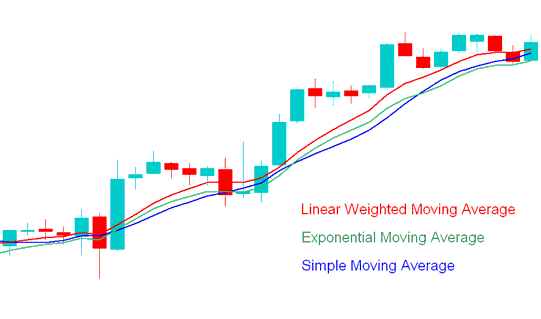SMA, EMA, LWMA and SMMA
There are four types of stock indices moving averages:
- Simple stock indices moving average
- Exponential stock indices moving average
- Smoothed stock indices moving average
- Linear weighted stock indices moving average
The difference between these 4 stock indices moving averages is the weight assigned in to the most recent stock price data.
SMA Indicator
Stock Indices Trading SMA indicator applies equal weight to the stock indices data used to calculate the simple moving average and is calculated by summing up the price periods of a chart and this value is then divided by the number of such stock price periods. For example stock indices simple moving average 10, adds the price data for the last 10 price periods and divides them by 10.
EMA Indicator
Stock Indices Trading EMA indicator applies more weight to the most recent stock price data and is calculated by assigning the latest stock price values more weight based on a percent P, multiplier that is used to multiply and assign more weight to the latest stock price data.
LWMA Indicator
Stock Indices Trading LWMA indicator moving averages applies more weight to the most recent stock price data and the latest data is of more value than earlier stock price data. Linear Weighted stock indices moving average is calculated by multiplying each of the stock indices closing prices within the series, by a certain weight coefficient.
SMMA Indicator
Stock Indices Trading SMMA Indicator is calculated by applying a smoothing factor of N, the smoothing factor is composed of N smoothing for N price periods.
The stock chart example illustrated below shows SMA, EMA and LWMA. The SMMA stock indices moving average is not commonly used so it is not shown below.
The LWMA stock indicator reacts fastest to stock price data, followed by the EMA and then the SMA.

SMA, LWMA, EMA - Types of Stock Indices Trading Moving Averages - SMA, EMA & LWMA
Day Stock Indices Trading with Exponential & Simple Moving Averages
The SMA and EMA stock indices moving averages are the most commonly used Moving averages to trade stock indices. Whereas the EMA stock indices moving average has a more sophisticated method of calculation, its more popular than the SMA stock indices moving average.
Simple Moving Average is the arithmetic mean of the closing prices in the price period based on the set time period where each time period is added and then it is divided by the number of time price periods chosen. If 10 is the price period used the price for the last ten stock price periods added up then it is divided by 10.
SMA stock indicator is the result of a simple arithmetic average. Very simple and some Stock traders tend to associate with the stock trend since it closely follows price action.
EMA on the other hand uses an acceleration factor and it is more responsive to the trend.
The SMA stock indices moving average is used in charts to analyze price action. If the price action in more than 3 or 4 time price periods the SMA then it's an indication that long stock trades should be closed immediately and the bullish momentum of the buy stock trade is waning.
The shorter the SMA price period the faster it is to respond to stock price change. SMA stock indicator can be used to show direct information regarding the stock trend of the stock market and the strength by looking at its slope, the steeper or more pronounced slope of the SMA is, the stronger the Stock Indices trend.
The Exponential Moving Average is also used by many traders in the same way but it reacts faster to the stock market moves and therefore it is more preferred by some stock traders.
The SMA and EMA can also be used to generate entry and exit points when stock indices. These Moving averages can also be combined with Fibonacci and ADX indicators to generate confirmation the stock signals generated by these moving averages.


